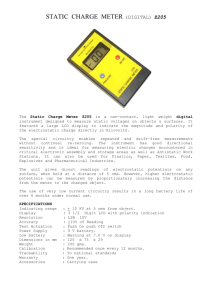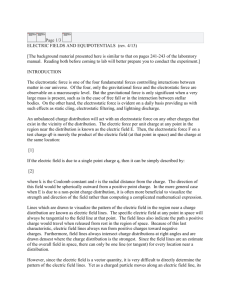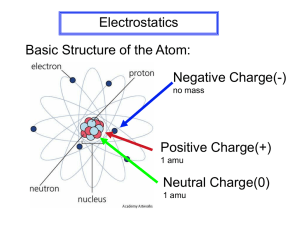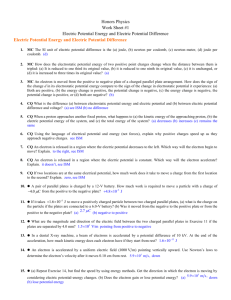Static Meter I
advertisement
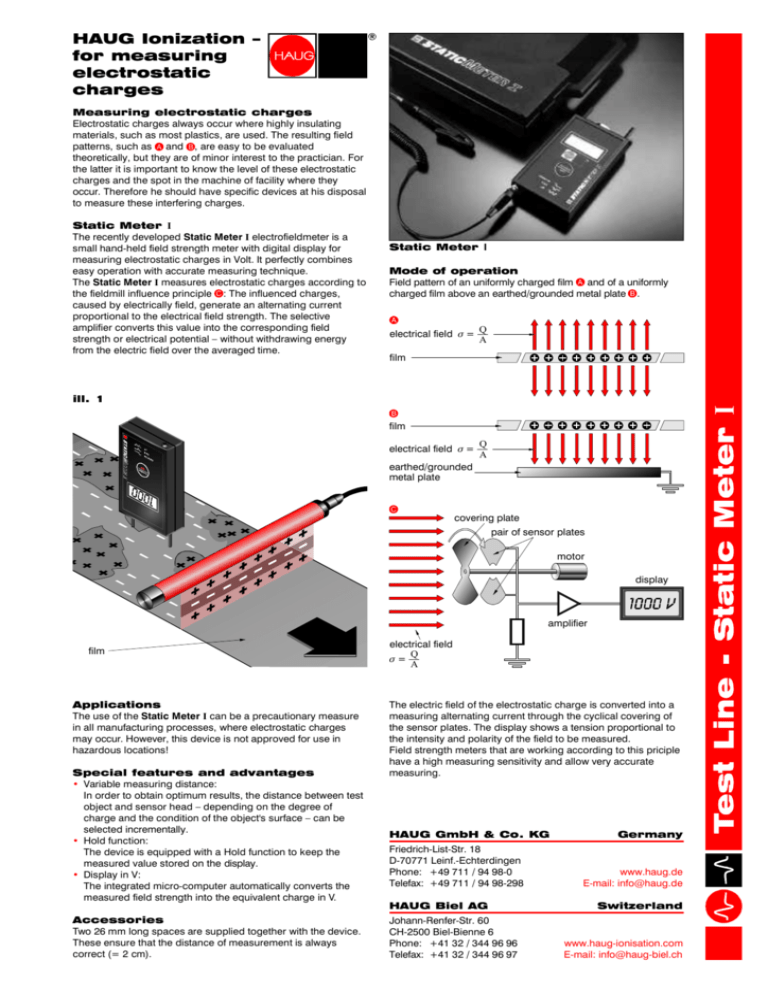
HAUG Ionization – for measuring electrostatic charges Measuring electrostatic charges Electrostatic charges always occur where highly insulating materials, such as most plastics, are used. The resulting field patterns, such as and , are easy to be evaluated theoretically, but they are of minor interest to the practician. For the latter it is important to know the level of these electrostatic charges and the spot in the machine of facility where they occur. Therefore he should have specific devices at his disposal to measure these interfering charges. Static Meter I The recently developed Static Meter I electrofieldmeter is a small hand-held field strength meter with digital display for measuring electrostatic charges in Volt. It perfectly combines easy operation with accurate measuring technique. The Static Meter I measures electrostatic charges according to the fieldmill influence principle : The influenced charges, caused by electrically field, generate an alternating current proportional to the electrical field strength. The selective amplifier converts this value into the corresponding field strength or electrical potential – without withdrawing energy from the electric field over the averaged time. Static Meter I Mode of operation Field pattern of an uniformly charged film and of a uniformly charged film above an earthed/grounded metal plate . Q electrical field s = –– A film ill. 1 film Q electrical field s = –– A earthed/grounded metal plate covering plate pair of sensor plates motor display amplifier film Applications The use of the Static Meter I can be a precautionary measure in all manufacturing processes, where electrostatic charges may occur. However, this device is not approved for use in hazardous locations! Special features and advantages • Variable measuring distance: In order to obtain optimum results, the distance between test object and sensor head – depending on the degree of charge and the condition of the object's surface – can be selected incrementally. • Hold function: The device is equipped with a Hold function to keep the measured value stored on the display. • Display in V: The integrated micro-computer automatically converts the measured field strength into the equivalent charge in V. Accessories Two 26 mm long spaces are supplied together with the device. These ensure that the distance of measurement is always correct (= 2 cm). electrical field Q s = –– A The electric field of the electrostatic charge is converted into a measuring alternating current through the cyclical covering of the sensor plates. The display shows a tension proportional to the intensity and polarity of the field to be measured. Field strength meters that are working according to this priciple have a high measuring sensitivity and allow very accurate measuring. HAUG GmbH & Co. KG Friedrich-List-Str. 18 D-70771 Leinf.-Echterdingen Phone: +49 711 / 94 98-0 Telefax: +49 711 / 94 98-298 HAUG Biel AG Johann-Renfer-Str. 60 CH-2500 Biel-Bienne 6 Phone: +41 32 / 344 96 96 Telefax: +41 32 / 344 96 97 Germany www.haug.de E-mail: info@haug.de Switzerland www.haug-ionisation.com E-mail: info@haug-biel.ch Technical data Static Meter I Type: Static Meter I Order-No: 12.7210.000 Power supply: 9 V - alkaline battery IEC 6F22 or 9 V NiCd or NiMH accu Measuring ranges: Distance 1 cm: 0 .. 10 kV, max. resolution 1 V Distance 2 cm: 0 .. 20 kV, max. resolution 2 V Distance 5 cm: 0 .. 50 kV, max. resolution 10 V Distance 10 cm: 0 .. 100 kV, max. resolution 10 V Distance 20 cm: 0 .. 200 kV, max. resolution 20 V Display: alphanumeric LCD-display, two lines with 12 digits each Operating time: approx. 10 hours in continious duty Balancing: within the homogeneous field of a plate capacitors, measuring device built in the center of the pasted plate plate size 100 mm x 100 mm, distance between plates 20 mm Operating temperature: +5 °C to +50 °C Storage/transport temperature: -15 °C to +60 °C Weight: 130 g (without battery) Subject to technical changes! 25 116 26 V 1.2
